


March 2025
Considerations for E-Bikes in Policy, Planning, and Design
Natalie Chyba, P.E.; AJ Fisher, P.E.; Angelica Rocha, AICP
E-bikes are rapidly transforming urban mobility, offering a sustainable, efficient, and accessible transportation option. As cities and agencies adapt to this shift, how can policies, planning strategies, and infrastructure design evolve to accommodate e-bikes safely and effectively?
This ITE Quick Bite explores key considerations for integrating e-bikes into transportation systems, including policy frameworks, planning initiatives, and design solutions that support multimodal connectivity. Learn how states and localities are addressing e-bike regulations, such as classification systems and operational guidelines, to create consistent and safe riding environments. Discover best practices for incorporating e-bikes into active transportation, curbside management, electrification, and transit plans.


March 2025
Evaluating the Impacts of the Safe System Approach on Safety and Operations
Karla C. Rodrigues Silva, Gustavo Riente de Andrade, and Shen Dong
The Safe System Approach (SSA) seeks to eliminate crashes resulting in death and serious injuries by anticipating human error and reducing impact forces. This Quick Bite examines how operational changes affect safety, highlighting innovative evaluation methods and data-driven countermeasures. By integrating SSA principles with tools like Highway Capacity Software (HCS), transportation professionals can enhance both mobility and safety. This resource provides insights into practical, low-cost interventions to improve roadway conditions for all users.
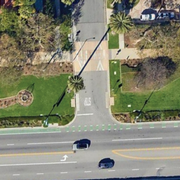

December 2024
Addressing Turn Conflicts with Vulnerable Road Users
Patrick Wright; Jessie Holzer Carpenter, PTP; Joan Hudson; Barbara Mosier, P.E., PTOE; Carrie Long; Christa Greene. P.E.; Cecily Foote; Jessica Schoner, Ph.D.; Josh Workman, P. Eng, RSP1; Christina Fink, P.E., PTOE
Discover proven strategies to address turn conflicts with vulnerable road users, such as pedestrians, cyclists, and those who use mobility devices. These road users face significantly higher risks in intersections, where turning movements can lead to severe crashes. The new Quick Bite, "Addressing Turn Conflicts with Vulnerable Road Users," highlights effective solutions, including innovative intersection designs, signal timing improvements, and policy adjustments aligned with the Safe System Approach. Real-world case studies from Austin, Texas, and Beverly Hills, California, illustrate practical implementations that reduce risk and enhance safety. Download this resource today and be part of the movement to eliminate traffic-related fatalities and serious injuries.


December 2024
Getting Ready for Electric Vehicles: The Role of Transportation Engineers and Planners in Advancing EV Charging Stations for Residential Land Uses
Jack Lucero Fleck; Adam Gleason, EIT; Mi Hyeon [Christy] Jeon, Ph.D., P.E., PTOE, AICP; and Ransford S. McCourt, P.E., PTOE.
Electric vehicles (EVs) are transforming transportation, and ITE’s Technical Brief, "Getting Ready for EVs: The Role of Transportation Engineers and Planners in Advancing EV Charging Stations for Residential Land Uses," offers essential guidance for integrating EV charging into residential areas. With over 80 percent of EV charging occurring at home, the brief outlines strategies for equipping single-family and multi-family developments with charging infrastructure.
Transportation engineers and planners will gain practical advice on challenges such as retrofitting buildings, securing funding, and ensuring equitable access. The brief also highlights innovative solutions, including partnerships with third-party providers, load management optimization, and EV-readiness requirements in building codes.
Whether your focus is policy, urban planning, or infrastructure, this resource equips you to promote EV adoption and build sustainable communities. Stay ahead in this transportation evolution—download the brief today and help create a cleaner, more connected future.
Free for ITE members; $25 for non-members.
Download/Purchase
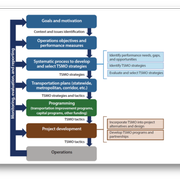

November 2024
Transportation Systems Management and Operations 101
Joe Gregory (FHWA); Kamar Amine (Mead & Hunt); Alican Karaer (Iteris); and Achilleas Kourtellis (CUTR)
The Transportation Systems Management and Operations 101 Quick Bite introduces transportation professionals to the foundational strategies of Transportation Systems Management and Operations (TSMO). Learn how TSMO optimizes safety and efficiency by leveraging innovative approaches such as traffic incident management, congestion pricing, and connected vehicle technologies. This resource covers real-world applications, planning integration, and agency best practices to mainstream TSMO. Explore the latest insights and strategies to enhance system performance and drive smarter transportation solutions. Download now to transform your approach to transportation operations.
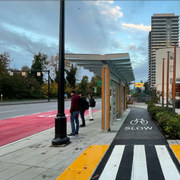

November 2024
New Design Guide for Bus Stops Adjacent to Cycling Infrastructure in British Columbia, Canada
Cristina Lucca, EIT, Elnaz Ansari, P.Eng.; Brian Patterson, RPP, MCIP, PMP, RSP1; and Frank A. Consoli, Ph.D, P.E. PTOE, AICP, LEED
The "New Design Guide for Bus Stops Adjacent to Cycling Infrastructure in British Columbia, Canada"Quick Bite highlights innovative design strategies for integrating transit stops with cycling infrastructure. Based on the award-winning Design Guide for Bus Stops Adjacent to Cycling Infrastructure, this resource addresses accessibility challenges and offers 45 actionable recommendations to improve safety and efficiency. With insights from pilot projects across British Columbia, it provides practical guidance for transportation professionals. Whether you're improving wayfinding, mitigating conflicts, or designing for all users, this Quick Bite delivers essential tools for modernizing multimodal transportation systems.


October 2024
How Metropolitan Planning Organizations Can Address Public Health
Kelly Rodgers, Owner and Principal, Streetsmart Planning LLC; Corinne Arriaga, AICP, CPH, Senior Transportation Planner, City of Sarasota; Elwyn Gonzalez, AICP, Associate Transportation Planner, Arlington County, VA Department of Environmental Sciences
“How Metropolitan Planning Organizations Can Address Public Health” explores how MPOs can integrate health considerations into transportation planning, ensuring communities benefit from safer and more sustainable networks. This Quick Bite details four key strategies: engaging public health professionals, developing health-focused plans, incorporating health into long-range planning, and prioritizing health in transportation programming. With practical examples and actionable insights, this paper is essential for transportation professionals committed to enhancing public health through effective planning. Download and share to build healthier, more resilient communities today!
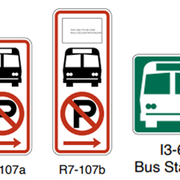

July 2024
Vehicular Traffic Warning Signs for Buses – Guiding the Creation of a Bus Symbol
Jay Jackson, P.E., and Ransford McCourt, P.E., PTOE; ITE Transit Committee: Chair Eric Swenson, P.E., PTOE, PTP, and Vice Chair Dan Ross, PL Eng, RPP, MCIP; ITE Complete Streets Council: Chair Natalie Chyba and Vice Chair Adam Smith, P.E., PTOE
Updated with MUTCD, 11th edition content
The Quick Bite report on "Vehicular Traffic Warning Signs for Buses" highlights the pressing need for an advanced warning sign for busway and BRT crossings in the United States. With the completion of numerous significant transit projects, the absence of such a sign in the Manual on Uniform Traffic Control Devices (MUTCD) has become increasingly apparent. The ITE Transit Committee formed a task force to address this gap by studying symbols used worldwide and coordinating with ongoing FHWA research efforts. Key insights from the report include:
- Global Symbol Synthesis: An analysis of over 50 variations of bus symbols used in different countries, identifying eight primary groupings.
- Survey Results: A survey of over 300 North American transportation professionals to determine preferences for bus crossing symbols. The survey highlighted a preference for certain design elements, leading to the development of a hybrid symbol concept.
- Ongoing FHWA Research: Summary of the Federal Highway Administration's (FHWA) efforts in a pooled fund study to assess traffic control device symbols, including the proposed bus crossing symbol.
By understanding global practices and leveraging survey insights, professionals can contribute to the adoption of effective bus crossing symbols in future MUTCD revisions.
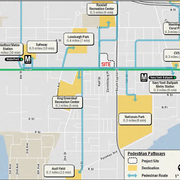

July 2024
Multimodal Transportation Impact Analysis Case Study – Establishing an Urban Development Review Program: DC's Comprehensive Transportation Review (CTR) Guidelines
Aaron Zimmerman, Washington Metropolitan Area Transit Authority (WMATA) and Jamie Henson, Kittelson Associates
As urban populations surge and the demand for sustainable development grows, transportation professionals face the challenge of minimizing vehicle travel without expanding road capacity. The District of Columbia Department of Transportation’s (DDOT) Comprehensive Transportation Review Guidelines offer a forward-thinking solution by setting new benchmarks for site design, curbside management, streetscape design, and more.
This case study, part of the Multimodal Transportation Impact Analysis (MTIA) series, highlights DDOT's innovative urban development review, prioritizing multimodal impacts since 2012. Key strategies include:
- Reduced off-street parking to lower driving demand.
- Focus on non-auto mitigation measures, like bike and pedestrian facilities.
- Multimodal trip generation for comprehensive travel pattern analysis.
- Pedestrian gap analysis to improve walking routes.
Transportation professionals can leverage DDOT’s proven methods for efficient, sustainable, and multimodal urban planning. Dive into this essential resource to lead modern transportation impact analysis.
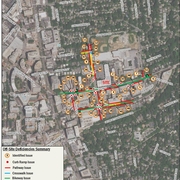

July 2024
Multimodal Transportation Impact Analysis Case Study – Increasing the Role of Development Projects on Multimodal Network Improvements: A Balanced Approach in a Suburban Maryland County with Diverse Land Use Contexts
Katie Wagner, PE, PTOE, Gorove Slade; Andrew Sandweiss, Gorove Slade; and Darcy Buckley, M-NCPPC
Discover how Montgomery County, Maryland, has revolutionized suburban transportation planning with its Local Area Transportation Review (LATR) guidelines. This case study outlines how the county integrates multimodal network improvements into development projects, creating a balanced approach for diverse land use contexts.
Key innovations include:
- Systematic Multimodal Improvements: Identifying deficiencies in pedestrian, bicycle, and transit networks through well-defined adequacy tests.
- Proportionality Guide: Setting cost caps for required off-site improvements based on project location and development program.
- Vision Zero Statement: Comprehensive speed studies and crash reviews to enhance safety without imposing improvement responsibilities on developers.
- Online Data Submission: Streamlining the submission process for transportation data, maintaining an up-to-date, accessible database.
Montgomery County’s LATR guidelines offer a scalable model for suburban jurisdictions aiming to incorporate multimodal analyses into their transportation impact assessments. By tailoring requirements based on urban, suburban, or rural contexts, the county ensures equitable and effective mitigation measures.


July 2024
Multimodal Transportation Impact Analysis Case Study – City of Austin Street Impact Fee (SIF) Program
Dan Hennessey, Director, Transportation and Public Works, City of Santa Rosa, California; Ashley Orr, Gorove Slade; Nathan Aubert, Austin Transportation and Public Works Department; & Eduardo Marino, Austin Transportation and Public Works Department
Discover how Austin’s Transportation Department revolutionized urban planning with its Street Impact Fee (SIF) program, detailed in this case study. Before 2016, Austin faced fragmented impact analyses and underfunded improvements. This study explores the introduction of administrative TIA guidelines and the Austin Strategic Mobility Plan (ASMP) for a more equitable and multimodal-focused approach.
Key innovations include:
- Transportation Demand Management (TDM): Promoting sustainable travel in all development applications.
- Street Impact Fee (SIF) Program: Charging new developments to fund necessary transportation infrastructure, ensuring equitable cost distribution and clearer expectations for developers.
- Roadway Capacity Plan (RCP): Prioritizing projects based on safety and mobility metrics, ensuring funds are used effectively.
- New Transportation Criteria Manual (TCM): Increasing predictability and focusing on multimodal improvements.
For transportation professionals, this case study offers insights into sustainable urban development, showcasing Austin’s commitment to reducing auto-dependence and enhancing multimodal infrastructure.
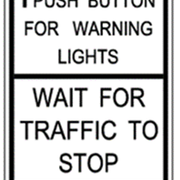

July 2024
Pedestrian Push Button Plaques and Signs
Special Task Force of the Traffic Engineering Committee
Unlock the potential of pedestrian safety with the latest "Pedestrian Push Button Plaques and Signs" Technical Brief by ITE. Updated with the 11th edition of the Manual on Uniform Traffic Control Devices (MUTCD), this essential resource incorporates the latest federal guidelines for pedestrian facilities.
This guide provides detailed insights into the evolution and best practices for pedestrian push button plaques and signs. It's an invaluable tool for municipal planners, traffic engineers, and urban developers, offering knowledge on enhancing pedestrian signal indications, accommodating ADA requirements, and ensuring uniformity and safety at intersections.
Key features include:
- An overview of the evolution of pedestrian signs to meet ADA standards.
- Analysis of commonly used signs and plaques, with feedback from 119 industry professionals.
- Findings on user interaction and the effectiveness of signage options.
- Recommendations for improving design and implementation.
- Global perspectives on pedestrian signage practices.
Don't miss out on this crucial update combining research, expert feedback, and actionable recommendations.
Free for ITE members; $25 for non-members.


May 2024
Big Data Use Cases in Transportation
ITE Data Use Cases, Strategies, Generators, and Consumers Subcommittee
Discover the transformative power of Big Data in transportation with the latest ITE Technical Brief, Big Data Use Cases in Transportation. Edited and reviewed by ITE experts, this comprehensive guide delves into the practical applications of Big Data across five crucial categories: Before and After Studies, Environmental Response Adaptation, Modeling, Multimodal Planning and Engineering, and Research and Innovation. Each category is enriched with detailed examples that not only demonstrate current use cases but also showcase the untapped potential of vast data sets to enhance and refine our transportation systems. Whether you're a professional in the field or an enthusiast for innovative solutions, this brief is your gateway to understanding and leveraging Big Data for future advancements in transportation networks. Secure your copy today and be part of the future of transportation planning and engineering!
Free for ITE members; $25 for non-members.
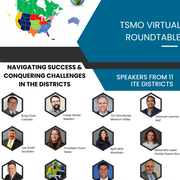

May 2024
TSMO Roundtable: Navigating Success and Conquering Challenges in the Districts
ITE TSMO Council in Partnership with the National Operations Center of Excellence
During ITE’s 2024 Virtual Spring Conference, the TSMO Council facilitated a compelling live session that thoroughly explored the core principles of Transportation Systems Management and Operations (TSMO) with TSMO champions from each of ITE’s Districts. Significantly enriched by their unique perspectives, the roundtable illuminated the diverse challenges and shared insights, highlighting the state of TSMO worldwide. ITE and NOCoE are releasing this online product to underscore the current landscape of TSMO, foster ongoing collaborative dialogue, and provide practitioners worldwide with access to a variety of perspectives.
Watch
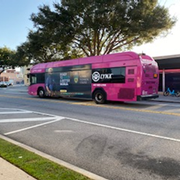

April 2024
Post Pandemic: Incentives and Operational Changes Transit Agencies Are Using to Regain Lost Ridership
Frank A. Consoli, ITE Transit Committee
Transit agencies experienced substantial declines in ridership attributable to the COVID-19 pandemic, resulting in significant revenue losses for each unoccupied seat during peak rush hours. The second quarter of 2020 witnessed a staggering reduction of more than 85 percent in transit ridership compared to the preceding year. In response, transit agencies have developed and implemented various strategies to incentivize more ridership on their systems. A literature review was conducted to explore the spectrum of initiatives implemented by these agencies and assess their efficacy. Among the observed methodologies, the reduction of fares emerged as a common strategy, while others explored collaborative ventures with businesses to offer incentives such as complimentary tickets to museums upon transit usage. The pandemic-induced decline in ridership afforded transit agencies an opportunity to reassess their existing service schedules and pivot towards accommodating shifting ridership patterns, transitioning away from the traditional 9-to-5 office commute paradigm towards extended service hours during evenings and weekends.
Free for ITE members; $25 for non-members.
Download/Purchase
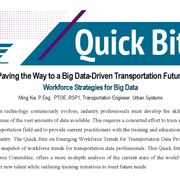

April 2024
Paving the Way to a Big Data-Driven Transportation Future: Workforce Strategies for Big Data
ITE Data Workforce Committee
As data collection technology continuously evolves, industry professionals must develop the skills and knowledge needed to make sense of the vast amounts of data available. This requires a concerted effort to train and attract talented people to the transportation field and to provide current practitioners with the training and education they need to keep pace with the industry. The Quick Bite on "Emerging Workforce Trends for Transportation Data Professionals" (March 2023) provided a snapshot of workforce trends for transportation data professionals. This Quick Bite, prepared by the ITE Data Workforce Committee, offers a more in-depth analysis of the current state of the workforce and identifies strategies to attract new talent while outlining training initiatives to meet future needs.
View


February 2024
Track Angle of Railroad Grade Crossings Effect on Bicycles
ITE Railroad Grade Crossing Committee | ITE Bicycle and Pedestrian Committee
**This resource has been updated based on the release of the 11th edition of the MUTCD.**
These practices can reduce track-related bicycle crashes and should be considered for potential implementation, if possible, during the design development process for railroad grade crossing locations.


February 2024
Two-Way Separated Bike Lanes at Railroad Grade Crossings
ITE Railroad Grade Crossing Committee | ITE Bicycle and Pedestrian Committee
**This resource has been updated based on the release of the 11th edition of the MUTCD.**
Two-way separated bicycle lanes can be challenging to implement due to the many conflicting movements involved. A gated railroad grade crossing requires particularly high levels of care in handling crossing movements. Adding bicycle movements outside of the vehicle space can greatly increase the complexity.
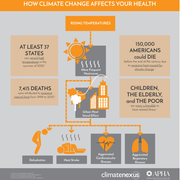

February 2024
Transportation and the Urban Heat Island Effect
ITE Transportation and Health Committee
A growing threat to individual and community health is the urban heat island (UHI) effect. Created through heat-absorbing surfaces in developed areas, the UHI contributes to extreme heat conditions, which can be costly and deadly. Transportation contributes to the UHI through heat-absorbing street surface materials, excessive street widths, surface parking lots, and a lack of street trees and other vegetation. However, if transportation is a contributor to the problem, transportation can also be a contributor to solutions.
View
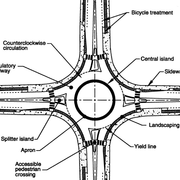

January 2024
Modern Roundabouts, from Design to Safety Evaluation
ITE Transportation Safety Council
This Quick Bite provides a brief overview of how roundabouts have grown in use in the U.S. and discusses some of the key aspects that roundabout developers should consider from the driver perspective.
View
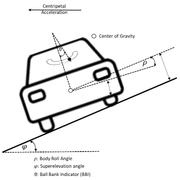

January 2024
Using Ball Bank Indicator (BBI) to Assess Lane Departure Risk
ITE Transportation Safety Council
In an effort to reduce fatalities on Georgia sharp curves, GDOT has established a curve inventory on all state routes. Various data are associated to these curves that include road geometry, crash data, traffic volume, and ball bank indicator (BBI). This quick bite summarizes GDOT's recent study with Georgia Tech to 1) assess the relationship between BBI and crash data on curves and 2) propose a strategy to proactively assess the risk of lane departures using BBI. Conducting a proactive assessment for lane departures is a critical practice since lane departures are often limited in number but are often severe.
View
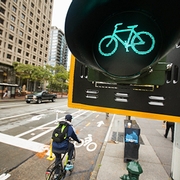

January 2024
ITE Bicycle Signals Resource Hub
ITE Pedestrian and Bicycle Standing Committee
The ITE Bicycle Signals Resource Hub which is intended to serve as a reliable and informative resource for the planning, design, implementation, and operational guidance of bicycle signals including design practices was recently updated with the addition of a series of new case studies. The case studies demonstrate ways in which public agencies have successfully implemented bicycle signals that meet their community’s desires to improve bicycle safety.
View


November 2023
Centering Transit Access, Speed, and Reliability in Quick-Build Complete Streets Projects
Complete Streets Council
Quick-build projects have come into the spotlight for their success in transforming implementation timelines in transportation projects. Public transit has also come into the spotlight as we recognize the crucial role it plays in regional mobility, equity, and climate resilience. This new ITE Informational Report serves as a guide for City staff, transit agency staff and practitioners on the steps and partnerships necessary to integrate transit access, speed, and reliability improvements into quick-build projects. Case studies from King County, WA; Los Angeles County, CA; Oakland, CA; Minneapolis, MN, and Washington, DC are included to demonstrate success stories and lessons learned.


October 2023
Pedestrian Push Button Plaques and Signs
Special Task Force of Traffic Engineering Council
Pedestrian plaques or signs at traffic signals have evolved from a simply informational purpose, to addressing pedestrian actuation, and more recently to educating the user regarding pedestrian signal indications. Changes to the design of signalized intersections to support the Americans with Disabilities Act and more common use of two accessible curb ramps per intersection corner, has further affected the need for and function of these signs. In the context of the Notice of Proposed Amendments (NPA) in advance of rulemaking for the upcoming 11th edition of the Manual on Uniform Traffic Control Devices and the final federal rule for the Accessibility Guidelines for Pedestrian Facilities in the Public Right-of-Way, this paper draws from a survey of practice to evaluate and better understand how practitioners utilize pedestrian push button signs and seek input on how greater uniformity might be possible.
Free for ITE members; $25 for non-members.
Download/Purchase


October 2023
ITE Parking Generation Manual, 6th Edition
The ITE Parking Generation Manual, 6th Edition is an educational tool for transportation professionals, zoning boards and others who are interested in estimating parking demand of a proposed development. The Parking Generation web app—ITEParkGen allows electronic access to the entire dataset that includes land use descriptions and data pots for all available combinations of land uses, time periods, independent variables and settings.


September 2023
Vehicle-Miles Traveled (VMT) as a Metric for Sustainability
ITE Sustainability Standing Committee
Examples and case studies described in this report show that vehicle travel reduction programs can provide more compact and multimodal communities. To be successful, they must be well planned and responsive to specific conditions and needs. Most vehicle travel strategies only affect a portion of total vehicle travel, such as commute, local, or urban travel, so reducing total VMT requires integrated programs that affect all types of travel.


April 2023
Traffic Signal Maintenance Handbook
Traffic Engineering Council | International Municipal Signal Association
ITE and the International Municipal Signal Association (IMSA) collaboratively prepared the Traffic Signal Maintenance Handbook, 2nd Edition to reflect the current state-of-the-practice and to provide the user with a broad overview of key considerations for the maintenance element of a traffic signal program. Available in both pdf and print.